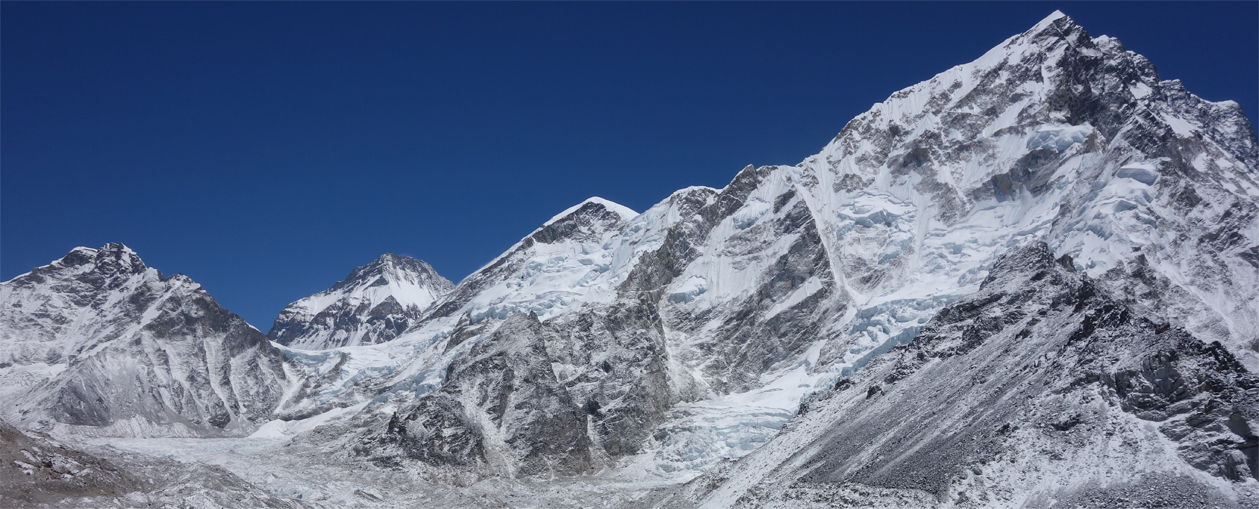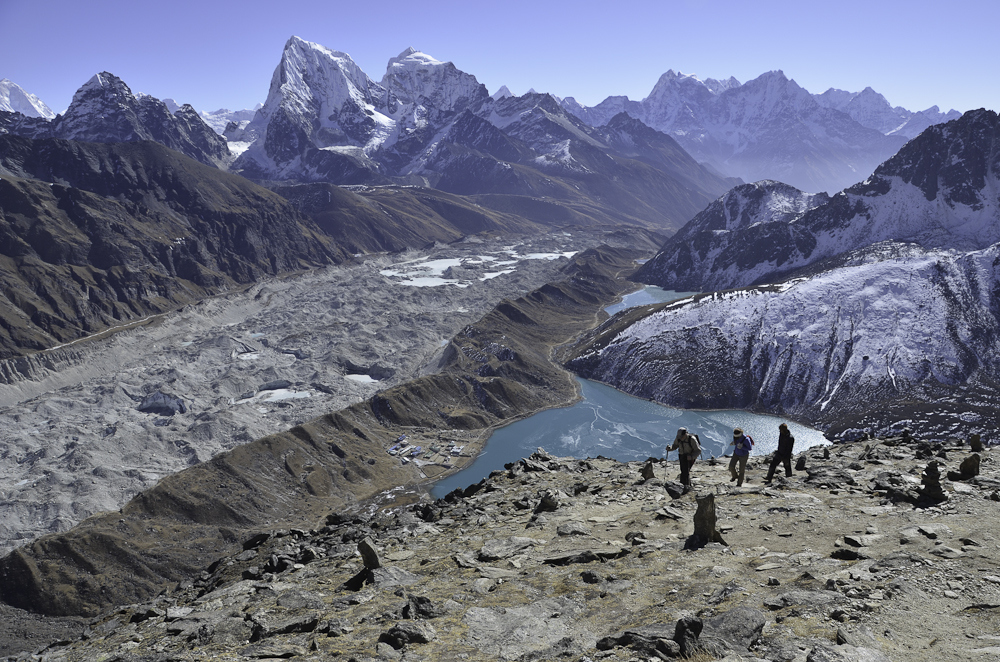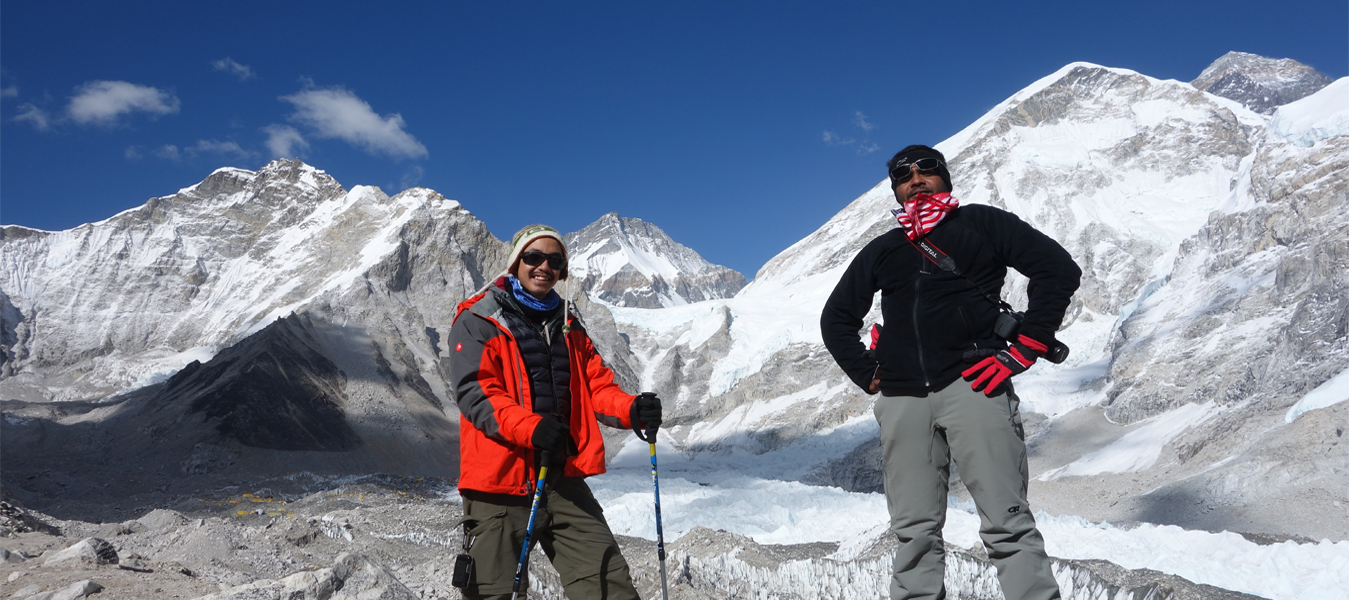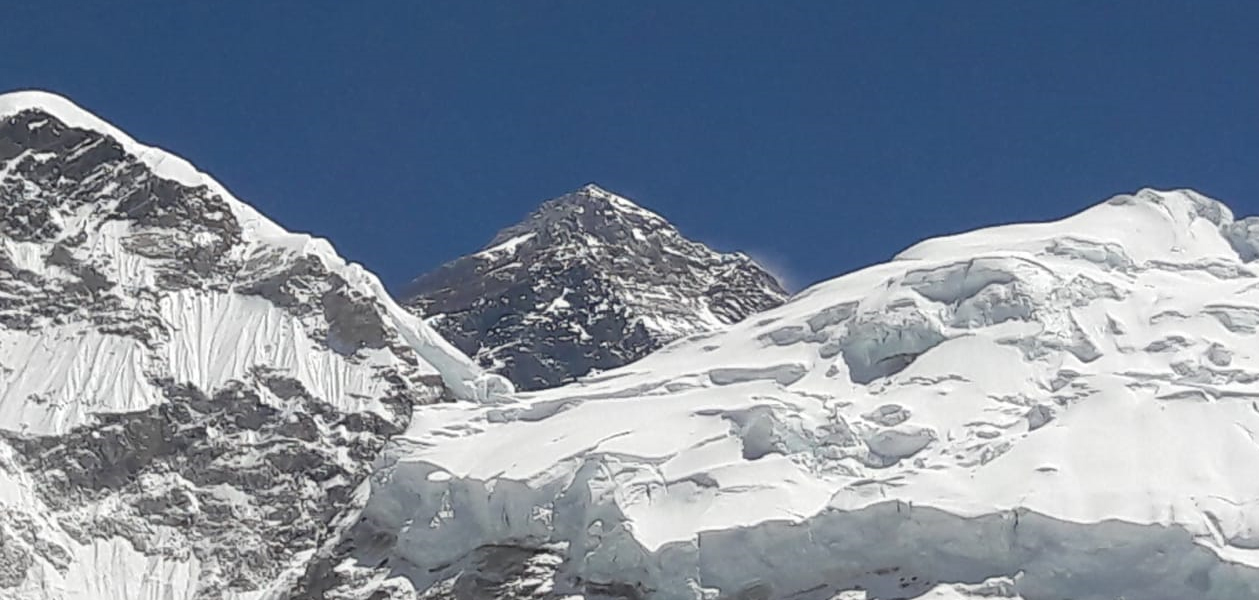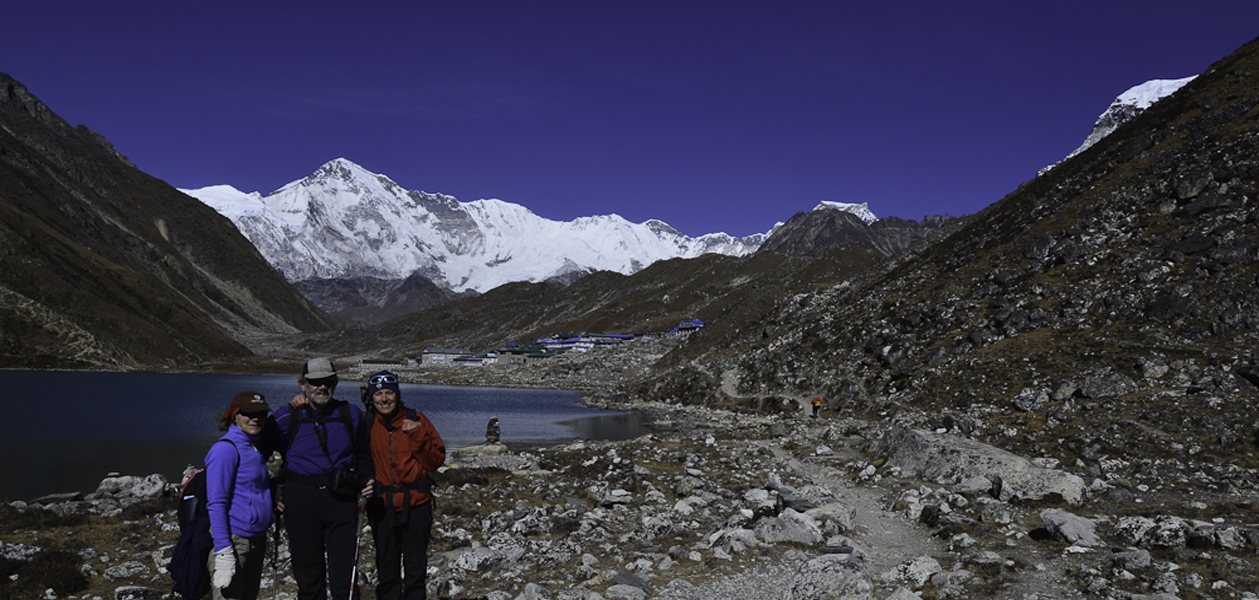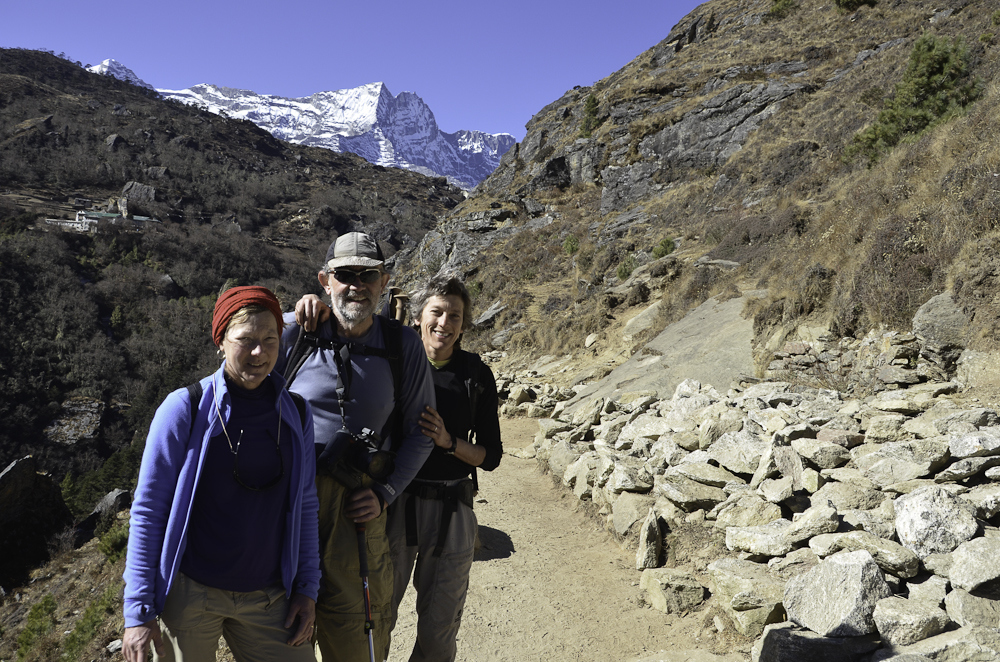Everest Three High Passes Trek-21 Days
Adventure Trek-
Duration
21 Days
-
Activity
Trekking
-
DifficultyStrenuous Trek
These treks are the most challenging and require a high level of physical fitness and mountaineering skills. The altitude may go up to 6,000 meters or more, and the terrain can be extremely rugged and steep, with challenging passes and technical sections.
-
Max. Altitude
5540m
-
Starts
Kathmandu
-
Ends
Kathmandu
-
Group Size
Minimum: 2 pax
-
Best Season
March-May/Sept-Dec
PRICE PER PERSON
- 1 PAX US$1597
- 2 PAX US$1491
- 3 PAX US$1376
- 4 PAX US$1381
- 5-10 PAX US$1344
- 11-20 PAX US$1312
- Highlights
- Itinerary
- Route Map
- What Included / Excluded
- Dates & Availability
- Photos & Videos
- Additional Information
- FAQ's
TRIP HIGHLIGHTS
- Majestic views of some of the world’s highest peaks, including Mount Everest (8,848m), Lhotse (8,516m), Nuptse (7,861m), Ama Dablam (6,812m), and many more.
- Experience the unique Sherpa culture and their warm hospitality.
- Kongma La Pass (5,535m), Cho La Pass (5,420m), and Renjo La Pass (5,360m),
three high passes offer breathtaking views of glacial valleys and pristine mountain scenery. - Iconic landmarks such as Namche Bazaar, Tengboche Monastery, and Dingboche.
- Magnificent views of Gokyo Valley, Gokyo Lakes, and the Ngozumpa Glacier.
- Opportunity to witness this remarkable biodiversity, connecting with the natural world .
- Visit monasteries and gain insight into their traditional way of life.
- Cozy tea houses for accommodation and meals for trekkers and serve as meeting points for fellow trekkers from around the world.
- Everest Base Camp (5,364m), allows you to witness the expedition preparations and get a sense of the mountaineering spirit.
- Encounter pristine landscapes that are relatively untouched by modern development.
Everest Three Pass Trek Overview
Everest three pass trek is one of Challenging and Strenuous trek in Everest region of Nepal. It is a variation of the classic Everest Base Camp trek, but it includes the crossing of three high mountain passes: Kongma La Pass (5,535m), Cho La Pass (5,420m), and Renjo La Pass (5,360m). This trek offers a more adventurous and off-the-beaten-path experience for those seeking a greater challenge and stunning views.
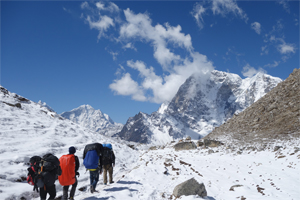
Everest three pass trek usually starts from Lukla, and in route to Everest Base Camp, you’ll pass through Namche Bazaar, the vibrant Sherpa town and commercial hub of the Khumbu region. It’s a great place to acclimatize and explore the local market, shops, bakeries, and visit the Sherpa Culture Museum. Tengboche is home to the famous Tengboche Monastery, one of the most significant monasteries in the Everest region. It offers panoramic views of Everest, Ama Dablam, and other peaks. You can witness the monks’ prayers and immerse yourself in the spiritual ambiance of the monastery.
In Everest three pass trek, The first high pass you’ll encounter is Kongma- La Pass, which requires careful navigation across rocky terrain and offers breathtaking panoramic views of the Everest region. From there, the trek continues to Everest Base Camp (5,364m), where you can witness the iconic Khumbu Icefall and the massive south face of Mount Everest.
After reaching Everest Base Camp, you’ll continue towards the second high pass, Cho La Pass. This pass requires some technical skills and involves traversing a glacier. The pass rewards you with stunning views of the surrounding peaks and a sense of accomplishment. In Everest three pass trek, next, your journey head towards the third high pass, Renjo-La Pass. This pass offers magnificent views of Gokyo Valley, Gokyo Lakes, and the Ngozumpa Glacier, the largest glacier in Nepal. The turquoise lakes of Gokyo are a sight to behold and provide a peaceful and serene setting amidst the majestic Himalayan landscape.
From Gokyo, you’ll descend to Lukla through the charming villages of Machhermo and Namche Bazaar, completing the circular route of the Everest Three Pass Trek.
Everest three pass trek offers breathtaking views of some of the world’s highest peaks, including Mount Everest (8,848m), Lhotse (8,516m), Nuptse (7,861m), Ama Dablam (6,812m), and many more. The panoramic views of the Himalayas are truly awe-inspiring and provide unforgettable memories. The Everest Three Pass Trek is known for its adventurous and challenging nature. Crossing three high passes involves steep ascents and descents, as well as traversing glacial terrain. It requires physical fitness, stamina, and a sense of adventure, making it a thrilling and rewarding experience for trekkers.
As you trek through this Everest three pass trek , you’ll encounter pristine landscapes that are relatively untouched by modern development. You’ll pass through remote valleys, glacial moraines, and rocky terrain, immersing yourself in the raw beauty of the Himalayas.
Table of Contents
Cultural Experience:
The Everest Three Pass Trek offers a rich cultural experience as you pass through Sherpa villages and interact with local communities. The Sherpas are the indigenous people of the Everest region and have a distinct culture deeply rooted in Tibetan Buddhism. During the Everest three pass trek, you’ll have the opportunity to visit monasteries, prayer flags, and mani walls adorned with Buddhist inscriptions. You can also explore the Sherpa way of life, sample their traditional cuisine, and learn about their customs and traditions.
Biodiversity:
The Everest Three Pass Trek showcases a remarkable biodiversity, considering the challenging high-altitude environment. You’ll encounter various flora and fauna along the trail, including alpine scrub, grasslands, medicinal herbs, mosses, lichens, and rhododendron forests.
The region is home to elusive mammals like snow leopards, Himalayan tahrs, musk deer, and a variety of bird species, including the Himalayan Monal and Blood Pheasant. Despite the harsh conditions, the Everest region supports a surprising range of life, highlighting the resilience and adaptation of species to high-altitude environments.
Climate:
One of the most thrilling and difficult trekking routes in the Everest region of Nepal, the Everest Three Pass Trek, has a climate that changes dramatically with altitude and season. Trekkers experience a subtropical environment that starts in the lower valleys and is marked by moderate temperatures and sporadic rainfall, especially from June to August during the summer monsoon season. Although the blossoming rhododendron trees and rich foliage provide a gorgeous setting, hikers should be ready for muddy routes and the potential for leeches during this season.
Trekkers, however, need to be ready for the bitterly cold and severe weather that may be found at higher altitudes, particularly while traversing the three high mountain passes of Renjo La, Cho La, and Kongma La. Each of these passes, which rise above 5,000 meters (16,400 feet) in elevation, offers extreme difficulties, such as frigid temperatures, powerful winds, and the possibility of precipitation or blizzards, especially in the winter (December to February). To safely navigate these high-altitude passes and guarantee a memorable and fulfilling trekking journey along the Everest Three Pass route, proper acclimatization, sufficient equipment, and careful planning are needed.
Difficulty Level:
Everest Three Pass Trek is considered a strenuous and challenging trek. It involves traversing three high passes: Renjo La Pass, Cho La Pass, and Kongma La Pass, each reaching altitudes above 5,000 meters (16,404 feet). The trail includes steep ascents and descents, rocky terrain, and sections of snow and ice. Good physical fitness, previous trekking experience, and acclimatization are crucial for successfully completing this demanding trek.
Duration:
The typical duration for the Everest Three Pass Trek is around 18 to 21 days, including acclimatization days. This timeframe allows for a gradual ascent, proper acclimatization, and exploration of the three high passes. However, the duration can vary depending on your itinerary, pace, and individual preferences.
Equipment:
Some essential equipment for the Everest Three Pass Trek includes sturdy and comfortable trekking boots, moisture-wicking and quick-drying base layers, warm layers including fleece jackets and thermal clothing, waterproof and windproof outer shell jackets and pants, a warm hat and gloves, sunglasses with UV protection, a sun hat, sunscreen, a backpack with a rain cover, a water bottle or hydration bladder, trekking poles, a sleeping bag suitable for cold temperatures, a first aid kit, water purification tablets or a water filter, energy snacks, and a camera to capture the awe-inspiring landscapes. You can also check the Equipment List By clicking the link:
Accommodation:
Along the Everest High Pass Trek, you’ll find tea houses and lodges that offer accommodation and basic facilities for trekkers. These accommodations provide a warm and comfortable place to rest and rejuvenate after a day of trekking. The amenities may vary from basic rooms with shared bathrooms to more comfortable options with private facilities in some areas. It’s advisable to bring a sleeping bag, as the tea houses may provide blankets but not always mattresses. Accommodations can get crowded during peak trekking seasons, so it’s recommended to book in advance or travel with a guide who can assist with arrangements.
Meals:
Touch the Himalayas takes care of your meals during the trek. Our experienced team ensures that you are provided with delicious and nourishing meals throughout your journey. You will enjoy a variety of local and international dishes, including Nepali cuisine such as dal bhat (rice and lentil soup), momo (dumplings), and Sherpa stew. We also offer western-style options like pasta, eggs, and sandwiches. Our cooks prepare all meals with great care and maintain high hygiene standards to keep you energized and satisfied during the trek.
Guide:
To enhance your trekking experience and ensure your safety, we provide experienced and knowledgeable guides who accompany you throughout the Everest Three High Pass Trek. Our guides are familiar with the trekking routes, high passes, and cultural aspects of the region. They offer valuable insights into the Sherpa culture, provide guidance on acclimatization, and ensure your well-being during the challenging sections of the trek. Our guides are dedicated to making your journey memorable and enjoyable.
Insurance:
Your safety is our top priority. We highly recommend that all trekkers have comprehensive travel insurance that covers high-altitude trekking in Nepal, including helicopter evacuation if necessary. Our team can assist you in understanding the specific insurance requirements and ensure that your policy provides adequate coverage for the Everest Three High Pass Trek. We want you to have peace of mind knowing that you are protected in case of any unforeseen circumstances.
Permits:
As part of our services, we handle all the necessary permits for the Everest Three High Pass Trek. This typically includes obtaining the Sagarmatha National Park Permit, TIMS (Trekkers’ Information Management System) card, and any other permits required for the trek. We take care of the paperwork and ensure that you have all the necessary permits before starting the trek. This allows you to focus on the journey and enjoy the stunning landscapes and challenging passes without any administrative hassle.
At Touch the Himalayas, we are dedicated to providing exceptional facilities and services for your Everest Three High Pass Trek. From comfortable accommodation and delicious meals to experienced guides, insurance guidance, and necessary permits, we aim to make your trekking experience safe, memorable, and hassle-free. Our dedicated team is here to ensure your satisfaction and enjoyment as you embark on this challenging and rewarding adventure in the Everest region.
All the trip grading can be view here.
If you have any confusion for booking process please visit our booking process.
Itinerary
Welcome at Tribhuvan International Airport, then transfer to your hotel.
Trek preparation and introduce with trekking staffs
Kathmandu-Lukla-Phagding
Phakding trek to Namche Bazaar
Acclimatization day at Namche Bazaar
Namche to Tengboche (3867m, 5hours walking)
Tengboche (3,867m) trek to Dingboche (4,412m/14,471ft). 5.5 hrs.
Another Acclimatization day at Dingboche
Dengboche to Chhukung (4700m, 3 hours walking).
Trek from Chhukung to Lobuche (4930m) via Kongma-La (5546m) pass
Lobuche to Gorakshep (5,160m / 16,925ft) & trek to EBC (5,364m / 17,595ft)6 hrs
Visit Kala Pattar (5,550m/18,204ft) and Dzongla - 6 Hrs
Dzongla to Dragnak (4700m, 7hours walking) via Chola pass (5368m)
Dragnak to Gokyo (4700m, 3 hours walking)
Mainly Rest day in Gokyo, climp up Gokyo Peak/ Gokyo Ri (5410 m/17749 ft)
Gokyo to Lungdeng(4600m) over the renzo pass (5338m,7/8 hours walking)
Lungdeng to Thame (3800m, 4 hour walking)
Thame to Namche Bazar 6 hours
Trek down from Namche to Lukla 6 Hours.
Fly out from Lukla to Kathmandu
Departure Flight Back to Say Goodbye and good and safe journey
Itinerary Note:
This itinerary is just the guide line, it can be changed (longer or shorter) as per our client's wishes, fitness, ground reality and weather condition. If you're not satisfied or have an alternative plan please feel free to discuss it with us By Clicking :- ASK QUESTION or COSTOMIZE YOUR TRIP.What's Included / Excluded
Cost Incluldes
- Airport pick up and drop off by Car, jeep, Hiace or Bus. Depends on the number of arrives.
- Complimentary welcome or farewell dinner according to the suitability of our client’s time.
- Beginning two nights stay on arrival in Kathmandu in tourist standard hotel with breakfast included (twin share basis)
- Kathmandu to Lukla (trekking starting point) and way back from Lukla to Kathmandu transfer by domestic flight of Clients and Guide.
- All necessary trekking and area permit & fees, (Everest National Park Permit and TIMs cards).
- Three meals a day during the trek (Breakfast/Lunch/Dinner)
- All accommodation during trek (Tea house/guesthouse)
- An experienced, English-speaking, government-licensed, first aid trained trekking guide and assistant guide (10 trekkers: 1 assistant guide)
- Expert local porters from Everest area (2 trekkers: 1 porter)
- Duffel bag, (to be returned after trip completion), complementary trekking maps. If needed down jacket and sleeping bag will be provided in rent.
- Staff costs including their salary, insurance, Equipment, transport, food and accommodations
- Rescue arrangements if necessary.
- Basic First-aid kit (carried by trekking guide)
- All government and local taxes for Trekking, Agency service charge and government tax/vat.
- Achievement Certificate
Cost Excludes
- International airfare and Nepal visa fee.
- Lunch and Dinner in Kathmandu
- Extra night accommodation in Kathmandu because of early arrival, late departure, early return from mountain (due to any reason) than in the scheduled itinerary
- Personal insurance which covers medical, emergency evacuation, loss or theft of property.
- Personal gears and equipment.
- Personal expenses such as laundry, hot showers, battery charging, Wifi, etc
- Entry fees and costs in sightseeing (temples, monasteries, etc)
- Tips and gratitude provided to guide and porter.
Fixed Departure
Can't find trip as your Schedule Date?
- Above mentioned departure dates “AVILABLE”‘ means these dates are currently open for bookings for the particular Trek. If the mentioned dates are not suitable with your preferred date, you can make your own private trip by clicking the box billow in the bottom.
- A date “GUARANTEED” means that we give guarantees that the costumers will be able to start theirs trek on the specified date, regardless of whether the seats are fully booked or not.
- “LIMITED”‘ Status refers to a type of seats booking for the trek, that has been certain seats available to book
- In the status, “CLOSED” means that the Trekkers seats are fully booked and there are no more seats available for new booking. Trekkers may be put on a waitlist for a chance to get a seat if there are cancellations unless your are requested to plan your own private trip by clicking the box billow in the bottom.
Photos & Videos
Additional Information
All the trip grading can be view here.
If you have any confusion for booking process please visit our booking process.

